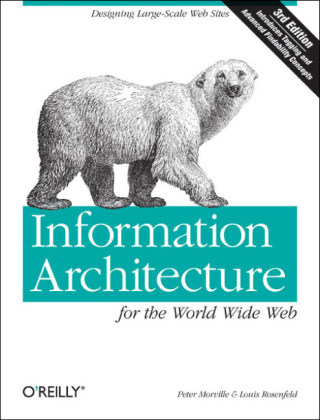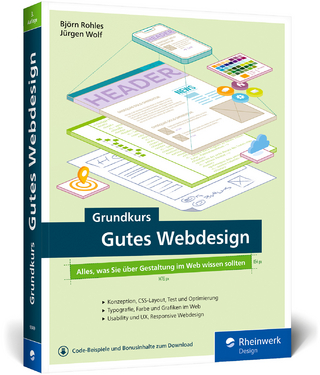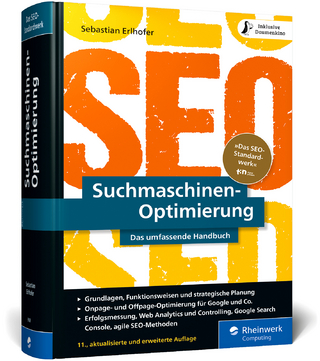
Information Architecture for the World Wide Web
O'Reilly Media (Verlag)
978-0-596-52734-1 (ISBN)
- Titel ist leider vergriffen;
keine Neuauflage - Artikel merken
The post-Ajaxian Web 2.0 world of wikis, folksonomies, and mashups makes well-planned information architecture even more essential. How do you present large volumes of information to people who need to find what they're looking for quickly? This classic primer shows information architects, designers, and web site developers how to build large-scale and maintainable web sites that are appealing and easy to navigate. The new edition is thoroughly updated to address emerging technologies -- with recent examples, new scenarios, and information on best practices -- while maintaining its focus on fundamentals. With topics that range from aesthetics to mechanics, Information Architecture for the World Wide Web explains how to create interfaces that users can understand right away. Inside, you'll find: * An overview of information architecture for both newcomers and experienced practitioners * The fundamental components of an architecture, illustrating the interconnected nature of these systems.
Updated, with updates for tagging, folksonomies, social classification, and guided navigation * Tools, techniques, and methods that take you from research to strategy and design to implementation. This edition discusses blueprints, wireframes and the role of diagrams in the design phase * A series of short essays that provide practical tips and philosophical advice for those who work on information architecture * The business context of practicing and promoting information architecture, including recent lessons on how to handle enterprise architecture * Case studies on the evolution of two large and very different information architectures, illustrating best practices along the way How do you document the rich interfaces of web applications? How do you design for multiple platforms and mobile devices? With emphasis on goals and approaches over tactics or technologies, this enormously popular book gives you knowledge about information architecture with a framework that allows you to learn new approaches -- and unlearn outmoded ones.
Peter Morville is president of Semantic Studios, an information architecture, user experience, and findability consultancy. For over a decade, he has advised such clients as AT&T, IBM, Microsoft, Harvard Business School, Internet2, Procter & Gamble, Vanguard, and Yahoo. Peter is best known as a founding father of information architecture, having co-authored the field's best-selling book, Information Architecture for the World Wide Web. Peter serves on the faculty at the University of Michigan's School of Information and on the advisory board of the Information Architecture Institute. He delivers keynotes and seminars at international events, and his work has been featured in major publications including Business Week, The Economist, Fortune, and The Wall Street Journal. You can contact Peter Morville by email (morville@semanticstudios.com). You can also find him offline at 42.2 N 83.4 W or online at Lou Rosenfeld is an independent information architecture consultant. He has been instrumental in helping establish the field of information architecture, and in articulating the role and value of librarianship within the field. Lou played a leading role in organizing and programming the first three information architecture conferences (both ASIS&T Summits and IA 2000). He also presents and moderates at such venues as CHI, COMDEX, Intranets, and the web design conferences produced by Miller Freeman, C|net and Thunder Lizard. He teaches tutorials as part of the Nielsen Norman Group User Experience Conference.
Foreword Preface Part I. Introducing Information Architecture 1. Defining Information Architecture A Definition Tablets, Scrolls, Books, and Libraries Explaining IA to Others What Isn't Information Architecture? Why Information Architecture Matters Bringing Our Work to Life 2. Practicing Information Architecture Do We Need Information Architects? Who's Qualified to Practice Information Architecture? Information Architecture Specialists Practicing Information Architecture in the Real World What Lies Ahead 3. User Needs and Behaviors The "Too-Simple" Information Model Information Needs Information-Seeking Behaviors Learning About Information Needs and Information-Seeking Behaviors Part II. Basic Principles of Information Architecture 4. The Anatomy of an Information Architecture Visualizing Information Architecture Information Architecture Components 5. Organization Systems Challenges of Organizing Information Organizing Web Sites and Intranets Organization Schemes Organization Structures Social Classification Creating Cohesive Organization Systems 6. Labeling Systems Why You Should Care About Labeling Varieties of Labels Designing Labels 7. Navigation Systems Types of Navigation Systems Gray Matters Browser Navigation Features Building Context Improving Flexibility Embedded Navigation Systems Supplemental Navigation Systems Advanced Navigation Approaches 8. Search Systems Does Your Site Need Search? Search System Anatomy Search Is Not an IT Thing Choosing What to Search Search Algorithms Query Builders Presenting Results Designing the Search Interface Where to Learn More 9. Thesauri, Controlled Vocabularies, and Metadata Metadata Controlled Vocabularies Technical Lingo A Thesaurus in Action Types of Thesauri Thesaurus Standards Semantic Relationships Preferred Terms Polyhierarchy Faceted Classification Part III. Process and Methodology 10. Research Process Overview A Research Framework Context Content Users Participant Definition and Recruiting User Research Sessions In Defense of Research 11. Strategy What Is an Information Architecture Strategy? Strategies Under Attack From Research to Strategy Developing the Strategy Work Products and Deliverables The Strategy Report The Project Plan Presentations 12. Design and Documentation Guidelines for Diagramming an Information Architecture Communicating Visually Blueprints Wireframes Content Mapping and Inventory Content Models Controlled Vocabularies Design Collaboration Putting It All Together: Information Architecture Style Guides Part IV. Information Architecture in Practice 13. Education Transition in Education A World of Choice But Do I Need a Degree? The State of the Field 14. Ethics Ethical Considerations Shaping the Future 15. Building an Information Architecture Team Destructive Acts of Creation Fast and Slow Layers Project Versus Program Buy or Rent Do We Really Need to Hire Professionals? The Dream Team 16. Tools and Software A Time of Change Categories in Chaos Questions to Ask Part V. Information Architecture in the Organization 17. Making the Case for Information Architecture You Must Sell The Two Kinds of People in the World Running the Numbers Talking to the Reactionaries Other Case-Making Techniques The Information Architecture Value Checklist A Final Note 18. Business Strategy The Origins of Strategy Defining Business Strategy Strategic Fit Exposing Gaps in Business Strategy One Best Way Many Good Ways Understanding Our Elephant Competitive Advantage The End of the Beginning 19. Information Architecture for the Enterprise Information Architecture, Meet the Enterprise What's the Goal of EIA? Designing an Enterprise Information Architecture EIA Strategy and Operations Doing the Work and Paying the Bills Timing Is Everything: A Phased Rollout A Framework for Moving Forward Part VI. Case Studies 20. MSWeb: An Enterprise Intranet Challenges for the User Challenges for the Information Architect We Like Taxonomies, Whatever They Are Benefits to Users What's Next MSWeb's Achievement 21. evolt.org: An Online Community evolt.org in a Nutshell Architecting an Online Community The Participation Economy How Information Architecture Fits In The "Un-Information Architecture" Appendix: Essential Resources Index
| Erscheint lt. Verlag | 2.1.2007 |
|---|---|
| Zusatzinfo | 1, black & white illustrations |
| Verlagsort | Sebastopol |
| Sprache | englisch |
| Maße | 178 x 233 mm |
| Gewicht | 833 g |
| Einbandart | Paperback |
| Themenwelt | Informatik ► Web / Internet ► Web Design / Usability |
| ISBN-10 | 0-596-52734-9 / 0596527349 |
| ISBN-13 | 978-0-596-52734-1 / 9780596527341 |
| Zustand | Neuware |
| Haben Sie eine Frage zum Produkt? |
aus dem Bereich


